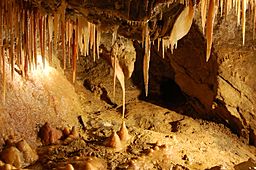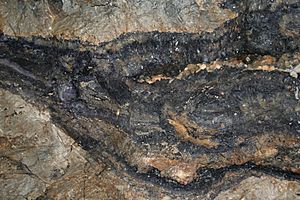Treak Cliff Cavern facts for kids
Quick facts for kids Treak Cliff Cavern |
|
|---|---|

The Ram's Head and the Stork, features of the Dream Cave chamber, part of the 'New Series'
|
|
| Location | Castleton, Derbyshire, England |
| OS grid | SK136831 |
| Length | 1,000 feet (300 m) |
| Elevation | 950 feet (290 m) |
| Discovery |
|
| Geology | Carboniferous limestone |
| Entrances | 2 |
| Show cave opened | 1935 |
| Lighting | Electric |
| Features |
|
| Cave survey | Trevor D. Ford, 1954 |
Treak Cliff Cavern is a cool show cave you can visit near Castleton in Derbyshire, England. It's part of a special natural area called a Site of Special Scientific Interest. This cave is one of only two places where a beautiful and rare mineral called Blue John is still found. The other place is the nearby Blue John Cavern.
To protect the cave, the Blue John you see inside isn't mined. But small amounts are carefully taken from other parts of the cave. This Blue John is then made into amazing items like bowls, jewelry, and ornaments.
The cave has two main parts:
- The Old Series was found by lead miners in the 1700s.
- The New Series was discovered in the 1920s when miners were blasting.
Only the Old Series has Blue John. But the New Series is full of amazing rock formations like flowstone, stalagmites (which grow up from the floor), and stalactites (which hang down from the ceiling). In 1921, three human skeletons and old stone tools from the Stone Age were found in a small cave nearby.
Contents
How Treak Cliff Cavern Formed
Treak Cliff is the hill where the cavern is located. This hill is made of a type of rock called Carboniferous Limestone. Long, long ago, the steep eastern side of the hill was the edge of a reef in a warm, tropical sea.
Later, the Earth's crust moved, pushing this reef above the sea. Over time, it wore away, forming a layer of boulders. Then, river sediments covered these boulders, creating shale and Millstone Grit sandstones. Even deeper, Coal Measures formed. This meant the limestone was buried deep underground, facing high heat and pressure.
Huge movements in the Earth's crust at the end of the Carboniferous period lifted these rock layers again. The top part of the rock layers wore away. Surface streams then flowed into cracks in the limestone. The water slowly dissolved the rock, creating the caverns we see today.
Today, no stream flows through Treak Cliff Cavern. But water still drips through the cave. Scientists have used dye to track this water. They found it comes out at Russet Well, near Peak Cavern in Castleton. It takes about 13 to 20 hours for the water to travel this distance!
After the caverns formed, they became decorated with beautiful flowstone, stalagmites, and stalactites. Scientists studied two stalagmite samples from the Aladdin's Cave section. They used a special dating method and found these formations are 111,000 years old! This shows the cave itself is much, much older.
The formations in Treak Cliff Cavern have different colors. They can be orange or red from iron, white from lead, and sometimes green or blue from copper. Some of the stalactites are twisted into strange shapes called helictites. This happens when the water flow changes direction.
What is Blue John?
Blue John is a very special and rare mineral found in Treak Cliff Cavern. It's a type of fluorspar (calcium fluoride).
Here's how it likely formed:
- Rainwater and trapped seawater mixed with tiny bits of elements from buried sediments. These included elements like chlorine, fluorine, calcium, and lead.
- Organic material from ancient sea animals formed hydrocarbons (like early oil and gas).
- Under high pressure, a hot, mineral-rich liquid formed. This liquid was forced into cracks and spaces in the rock.
- From this liquid, crystals like galena (lead sulphide) and fluorspar (calcium fluoride) grew.
At Treak Cliff, the liquid was very rich in fluorine. So, 99% of the mineral found here is fluorspar. These valuable deposits are found in different shapes and sizes within the rock.
What makes Blue John unique is its beautiful bands of blue-black and white colors. Scientists aren't completely sure why it has these colors. But it seems to need a rare mix of things:
- Porous limestone with a little hydrocarbon.
- Small traces of radioactive elements.
- A layer of rock that stops the mineral liquids from escaping.
- Lots of fluorine ions.
- Changing conditions while the crystals are growing.
Because all these things need to happen together, Blue John is very rare!
People love Blue John because of its attractive bands and its rarity. Ornaments made from it are very popular with collectors. In the past, Blue John was also mined from other places nearby, like Old Tor Mine and mines near Windy Knoll.
During World War II, some Blue John was dug up from the top of Treak Cliff. It was used as a flux in blast furnaces and in the chemical industry. In the 1970s, some people illegally mined Blue John from Old Tor Mine. This led to that mine being closed. Now, Treak Cliff Cavern and Blue John Cavern are the only two places where new Blue John is found. Both caves only sell raw Blue John to shops in Castleton. So, if you see it sold elsewhere, it's likely from old stocks.
History of the Cavern
The Old Series of the cave was probably found around 1745–1750 by miners looking for lead. By the 1750s, it was already known as a source of Blue John and was called Millers Mine. Mining continued through the 1800s. There's no record of the caves being open to the public back then. However, the nearby Blue John Caverns opened to visitors around 1800.
During World War I, there was a high demand for fluorspar. So, a lot of the beautiful Blue John was mined for use in factories. In 1921, miners found the remains of three human skeletons from the Neolithic period in a nearby cave. A few years later, in 1926, miners using explosives discovered a new part of the cave. This section, called the New Series, was beautifully decorated with stalactites.
Mining for commercial use stopped shortly after 1926. But in the 1930s, miners went back to get some stored Blue John. They found a new, easier way into the New Series! This made people think about opening the cave for tourists. The landowner asked John Royse, whose family had worked with Blue John for generations, to prepare the cave for visitors.
Treak Cliff Cavern officially opened to the public at Easter in 1935. Some of the named sections inside the show cave include:
- The Witch's Cave
- The Fossil Cave
- Aladdin's Cave
- Fairyland
- The Dream Cave
- The Dome of St Paul's
Some of the rock formations also have names because they look like other things. For example, there's the Stork, which is part of the cavern's logo, and the Ram's Head, both in the Dream Cave.
The Lost Vein
In 1945, the Harrison family took over running the cavern. They still operate it today! The person leaving, John Royse, who was close to retiring, said he had found a big, new source of Blue John in the cave. Royse planned to show the location to 19-year-old Peter Harrison. But he passed away before he could tell anyone where it was.
This "lost vein" was hidden by wooden boards, a piece of carpet, and a layer of clay. It was finally rediscovered in 2013 by John Turner, who is Peter Harrison's grandson! At the current rate of mining, this new find is expected to last for at least ten years. This exciting discovery even led to a visit from the BBC's Countryfile TV show later that year.
The Ridley Vein
In 2015, another new vein of Blue John was found very close to the tourist path. A miner discovered it while trying a new way of exploring with a special chainsaw. This was the first new source of Blue John found in 150 years! It was named the Ridley Vein after the miner who found it.







